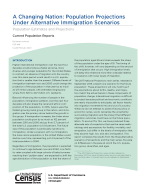A Changing Nation: Population Projections under Alternative Migration Scenarios
A Changing Nation: Population Projections under Alternative Migration Scenarios
Introduction
The 2017 National Projections Main Series, released in September 2018, presents one scenario for the future population. These projections will only hold true if the assumptions about births, deaths, and migration match the actual trends in these components of population change. International migration is difficult to project because political and economic conditions are nearly impossible to anticipate, yet factor heavily into migration movements into and out of a country. While we make no attempt to predict future policy or economic cycles, we do recognize the uncertainty surrounding migration and the impact that different migration outcomes could have on the future population. To account for this, we have produced three alternate sets of projections that use the same methodology and assumptions for fertility, mortality, and emigration but differ in the levels of immigration that they assume: high, low, and zero immigration. This report compares the results from the three alternative scenarios of projections and the main series, focusing on differences in the pace at which the U.S. population grows, diversifies, and ages.
Others in Series
Publication
Publication
Publication




